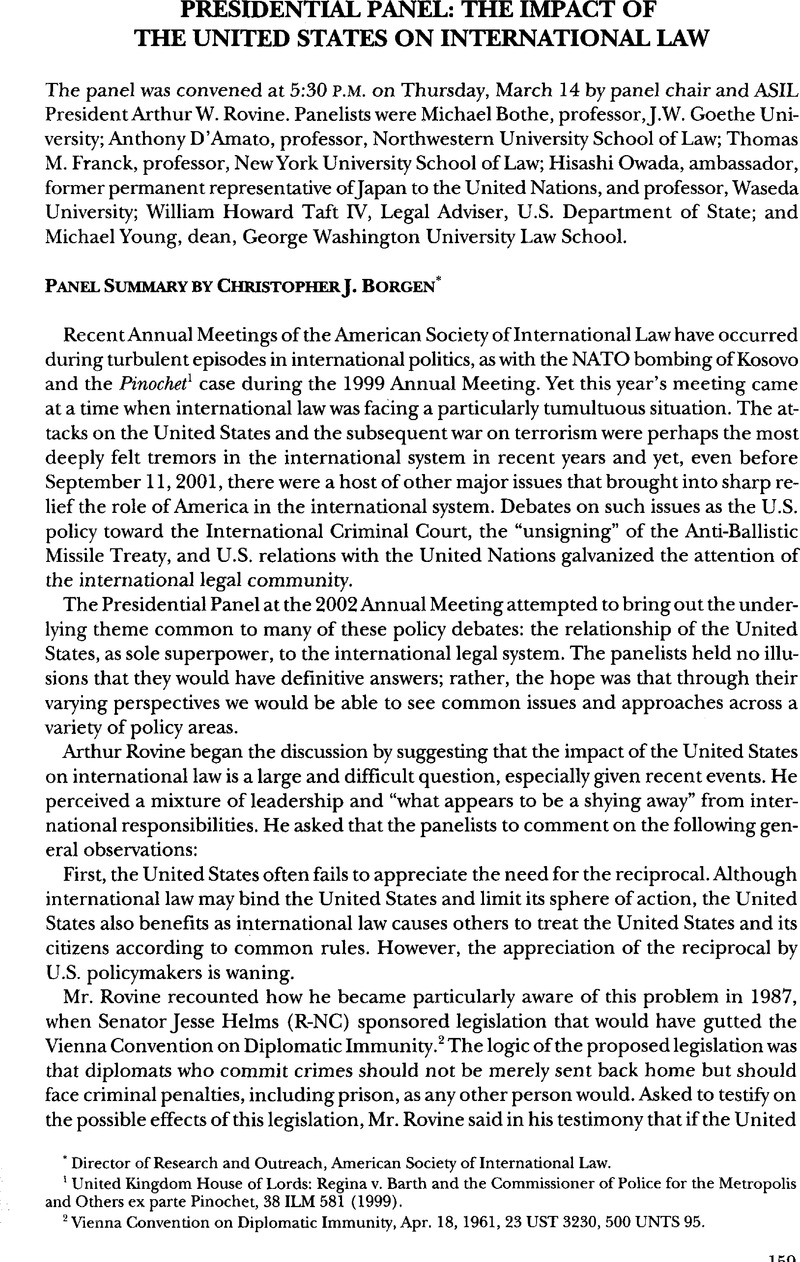No CrossRef data available.
Article contents
Panel Summary by Christopher J. Borgen
Published online by Cambridge University Press: 28 February 2017
Abstract

- Type
- Presidential Panel: The Impact of the United States on International Law
- Information
- Copyright
- Copyright © American Society of International Law 2002
References
1 United Kingdom House of Lords: Regina v. Barth and the Commissioner of Police for the Metropolis and Others ex parte Pinochet, 38 ILM 581 (1999).
2 Vienna Convention on Diplomatic Immunity, Apr. 18, 1961, 23 UST 3230, 500 UNTS 95.
3 Cf. The Landmark Thucydides 352 (Robert B. Strassler ed., Touchstone: 1996) (stating the well-known phrase that the “strong do what they can and the weak suffer what they must”).
4 Franck, Thomas M., Who Killed Article 2(4)? Or: Changing Norms Governing the Use of Force by States, 64 AJIL 809 (1970)CrossRefGoogle Scholar.
5 The Kellogg-Briand Pact, also known as the General Treaty for the Renunciation of War or the Pact of Paris, was formulated by U.S. Secretary of State Kellogg and French Foreign Minister Briand in 1928. According to the Penguin Dictionary of International Relations, signatories “renounce [d] war as an instrument of national policy” and agreed that all disputes should be settled by peaceful means. The treaty ultimately had 68 signatories. Kellogg-Briand Pact, in Graham Evans & Richard Newnham, Penguin Dictionary of International Relations 292 (1998). The Stimson Doctrine, which states that the U.S. will not recognize international territorial changes resulting from the use of force, was named after U.S. Secretary of State Henry Stimson. The doctrine was first set out in a note concerning japanese annexation of part of Manchuria in 1932 and was later included in the 1934 Budapest Articles of Interpretation of the Kellogg-Briand Pact.
6 Military and Paramilitary Activities (Nicar. v. U.S.), 1986 ICJREP. 14 (June 27).
7 Zverina, Ivan, U.S., Britain, France Veto U.N. Condemnation of Raid on Libya, UPI, Apr. 21, 1986 Google Scholar, available at Lexis, Nexis Library, UPI file.
8 For a discussion of process issues, see e.g., Thomas M. Franck, the Power of Legitimacy Among Nations (1990); Harold HongjuKoh, Why Do Nations Obey International Law? 106 Yale L.]. 2599 (1997).
9 The decisions concerning Breard’s appeals of his sentence are at Breard v. Pruett, 134 F. 3d 615 (4th Cir. 1998), cert, denied, Breard v. Greene, 523 U.S. 371 (1998); the decisions relating to the Vienna Convention case filed by Paraguay may be found at Republic of Paraguay v. Allen, 949 F. Supp. 1269 (E.D. Va. 1996), aff’d, 134 F.3d 622 (4th Cir. 1998), cert, denied sub nom. Breard v. Greene, 523 U.S. 371 (1998).
Recent such cases include Federal Republic of Germany v. United States, 526 U.S. 111 (1999); United States v. Alvarado-Torres, 45 F. Supp. 2d 986 (S.D. Cal. 1999); United States v. Lombera-Camorlinga, 170 F.3d 1241 (9th Cir. 1999) on rehearing en banc 206 F.3d 882 (9th Cir. 2000); see generally Aceves, William J., International Decision: Case Concerning the Vienna Convention on Consular Relations (Federal Republic of Germany v. United States), 93 AJIL 924 (1999 CrossRefGoogle Scholar).
10 United States v. Alvarez Machain, 504 U.S. 655 (1992).
11 Convention on Biological Diversity, 31 ILM 818 (1992).
12 Thomas M. Franck, Fairness in International Law and Institutions (1995).




